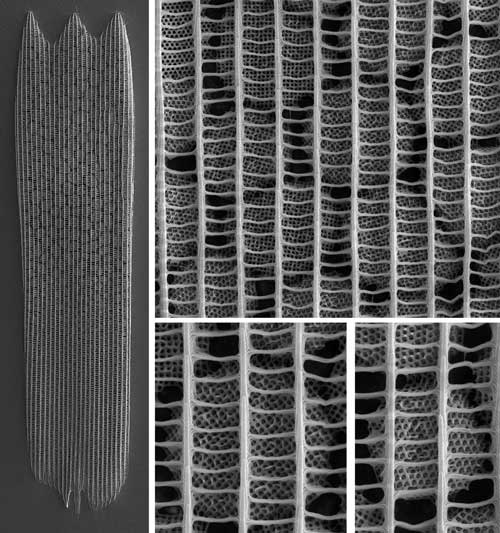| Posted: Apr 27, 2017 |
Understanding crystal growth in butterfly wings
(Nanowerk News) Tiny, individual crystals on the underside of a Mexican butterfly’s wings give the insect a distinctive green color that allows it to hide from predators. Researchers at the University of Fribourg’s Adolphe Merkle Institute (AMI), the Karlsruhe Institute of Technology (KIT), the University of Erlangen-Nuremberg (FAU) in Germany, and Murdoch University in Western Australia, have shown for the first time how these crystals might grow (Science Advances, "Butterfly gyroid nanostructures as a time-frozen glimpse of intracellular membrane development").
|
 |
| Ultrastructure of the Hairstreak butterfly wing scales at different resolutions. (Image: B. Wilts/Adolphe Merkle Institute) (click on image to enlarge)
|
|
The scientists investigated the nanostructure on the wing scales of the green Hairstreak butterfly. What they found on each wing scale were structured nanocrystals that were surprisingly not interconnected. Rather they were a series of regularly spaced points where so-called gyroid photonic structures had grown. Gyroids are labyrinth-like three-dimensional structures first described by NASA scientist Allan Schoen. These structures, which are partially pigmented, are responsible for the butterfly’s green color.
|
|
According to the researchers, the repetition of these nanostructures is similar to the wavelength of visible light which explains its peculiar optical property of producing a green colour without any pigment.
|
|
This was the first time this pattern was observed in butterflies, which are known for their particularly diverse wing scale structures. These structures are important to the insects for multiple functions such as signaling and water repellency. How the complex structures develop remains to this day largely unknown since it is impossible to observe on living specimens.
|
|
The researchers were however able to infer that the structure they observed, using electron and x-ray microscopy, grew in a multistep process. In a first stage, an enveloping casing or mould develops. Then it is filled by a biopolymeric gyroid structure with a different chemical composition. This growth pattern contradicts previous theories.
|
|
“Previous theories lacked the sampling and/or time resolution needed for the investigation,” explains Bodo Wilts, the lead AMI researcher on the project. “The unique structure found in these scales looks like it is still ‘growing’. Theories so far were based on single time points of the development. With our dataset, we are able to infer whether these are correct.”
|
|
The results give insights into how butterfly wing cells develop, but could also provide inspiration for new nanoscale assembly techniques. The structures are not only precisely formed, but also developed under normal temperature and pressure conditions.
|
|
“With optics and photovoltaics, we have taken inspiration from nature in terms of what structures we can copy and adapt. But we seem to neglect that we can also learn from the mechanisms nature employs to make these structures,” says Murdoch University’s Gerd Schroeder-Turk, one of the study’s co-authors. “Efficiencies and innovations are sure to be revealed if we can unpick these processes.”
|

